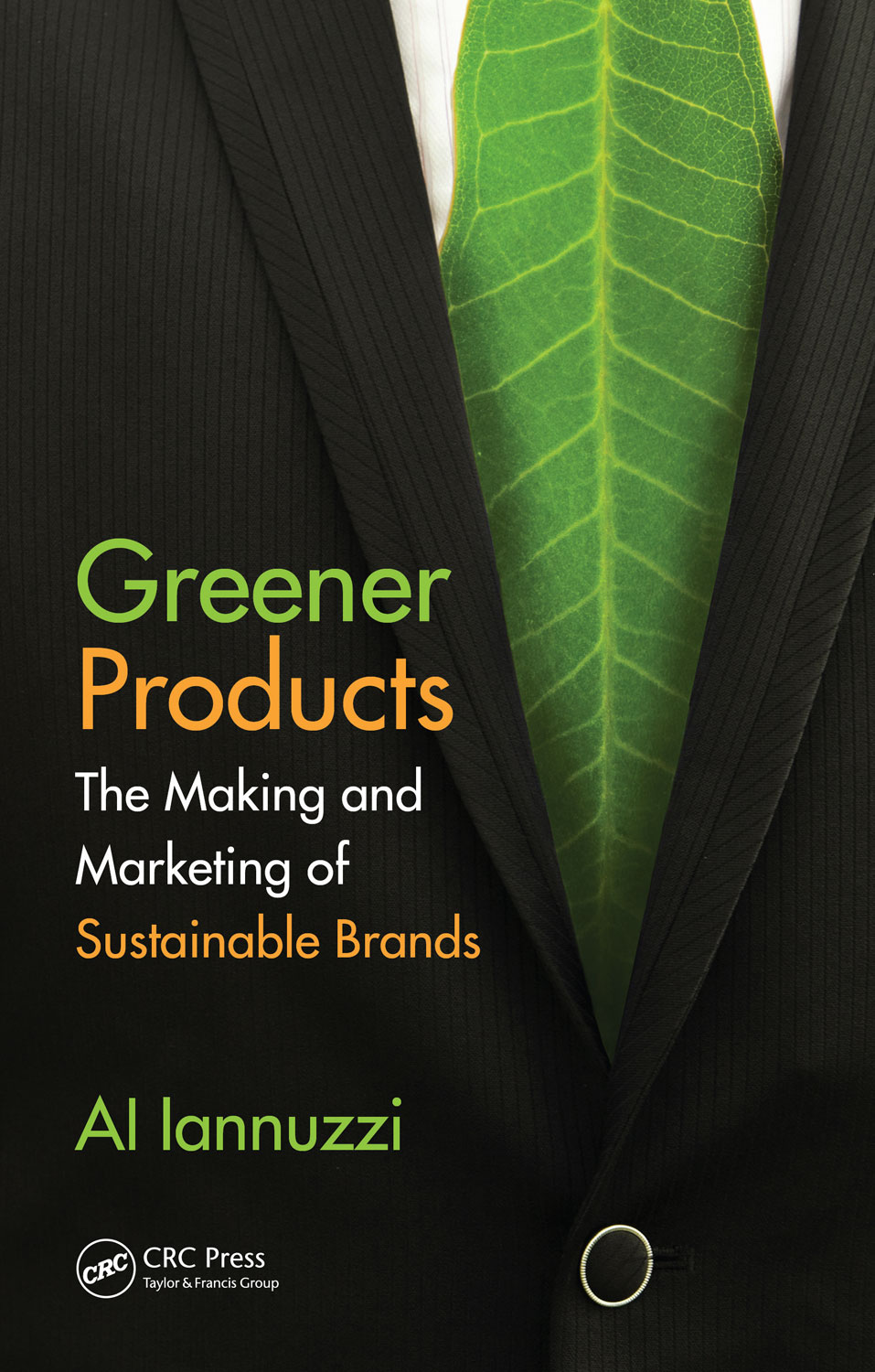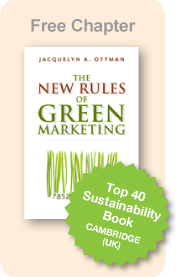Jacquie Ottman's
Green Marketing Blog
Book Review: Greener Products: The Making and Marketing of Sustainable Brands
February 03, 2012 by Jacquelyn Ottman
 In his recently released Greener Products: The Making and Marketing of Sustainable Brands (2012, CRC Press, 222 pp.), Al Iannuzzi offers a detailed and persuasive case for incorporating sustainability into your business model. Examining both the making and the marketing of green products, his writing is firmly situated in the language of business — making it a useful resource for both business leaders and students alike.
In his recently released Greener Products: The Making and Marketing of Sustainable Brands (2012, CRC Press, 222 pp.), Al Iannuzzi offers a detailed and persuasive case for incorporating sustainability into your business model. Examining both the making and the marketing of green products, his writing is firmly situated in the language of business — making it a useful resource for both business leaders and students alike.
Iannuzzi’s message is rooted in two core truths that we believe in strongly. First, there is no such thing as a truly green product: every product exerts some kind of impact, and the goal, therefore, is to create greener products. Secondly, a greener product is useless if no one knows about it. Communicating your sustainability strategy, therefore, is a critically important part of bringing your greener products (and values) to market. Both aspects are covered in this book.
The book is split into three distinct sections: making the business case, case studies of successful green initiatives, and green marketing. It is in the second section, Greener Products, with its detailed assessment of strategies, that represents the richest content in the book and differentiates this work from others in the field.
Fourteen Case Studies
In this section, Iannuzzi closely examines fourteen different case studies of businesses that have incorporated sustainable objectives. The wide range of companies he chooses to assess — including deeper green companies such as Method and Seventh Generation, major corporate conglomerates such as Johnson & Johnson and Unilever, and individual brands such as Samsung and Timberland — underscores just how many different ways there are to incorporate sustainability.
The companies which had sustainability built into the core of their business model might be considered the most authentically green. However, as Iannuzzi asserts, this path is by no means the only route to sustainability. For example, Ecomagination, the sustainability arm of GE, is successful because it frames its initiative in business terms. Rather than being driven by environmental altruism, Ecomagination is more explicitly profit-based, entirely contingent upon consumer demand for more energy-efficient products.
Framing it as a business objective — in terms of streamlining efficiency, enhancing brand image, and meeting consumer demand — underscores how sustainability can be approached from entirely different angles. Whether rooted in an engrained sense of environmental advocacy or more profit-driven motives, both ends of the spectrum ultimately net positive environmental results. Taking this kind of pragmatic, open approach to sustainable business offers an entry point for leaders who are new to sustainability and exploring different pathways to it.
In covering such a wide range of case studies, Iannuzzi explains the defining features of each organization’s sustainability strategy and integrates this with trends and themes in the green business arena. Each individual company he examines had its own nuanced sustainability strategy, utilizing a unique set of tools and methods. What these case studies share, as he explains, is an established framework for new/improved product development; internal goal-setting and commitment from the top levels of an organization; and strong, informative, and compelling communications.
Environmental Strategy
In the latter part of the case studies section, Iannuzzi goes into more specific detail on environmental management strategy. Segmenting strategies into four categories — compliant, market-driven, engaged, and shaping the future — he looks at the systems, programs, and tools that can help support your strategy, including lifecycle assessment (LCA), ISO standards, Design for Environment (DfE), and Environmental Impact Assessment (EIA), among others.
Iannuzzi’s discussion on emerging issues was especially useful. With the advancement of digital and Internet technologies, consumers are more equipped than ever before with information on business practices and the social and environmental costs they exact. Taking an anticipatory approach, therefore, is an important part of shifting towards sustainability.
Staying abreast of what’s going on online — issues consumers are talking about, information NGOs are reporting on, and so forth — can help a company mitigate potential future risk, enabling businesses to better strategize, keeping ahead of the curve on potential regulation to come. Being proactive, as opposed to reactive, is a wise strategy for all businesses, wherever they are on their pathway to sustainability.
Green Marketing
In the final section of the book, Iannuzzi shifts gears to green marketing. A critical part of green marketing strategy is knowing your consumer — their values, interests, beliefs, and so on — such that you can more effectively tailor your message and product. A key part of this is understanding which segment your consumer might fall into. Importantly, Iannuzzi suggests that successful green marketing is all about the “and”; products must be seen as competitively priced and work well and be green. By framing greenness as an additional benefit instead of the primary quality, the product is more likely to appeal to a wider range of consumers.
As sustainability has become a more mainstream concept, the motivations for going green are more diverse. For businesses seeking to capitalize on this demand, Greener Products offers a comprehensive overview of how to make the transition. Whether new to the field or seeking ideas for further improvement, Iannuzzi’s work is both highly informative and accessible — and will no doubt prove to be a useful resource for anyone interested in sustainable business practices.
Jacquelyn Ottman is an expert adviser on green marketing to Fortune 500 firms, entreprenuerial companies, and the U.S. government. She is the author of The New Rules of Green Marketing: Strategies, Tools and Inspiration for Sustainable Branding (Berrett-Koehler, 2011)
Cassidy Hooker is an associate at J. Ottman Consulting, Inc. and a recent graduate of the Sustainable Business & Communities program at Goddard College.



 ShareThis
ShareThis

